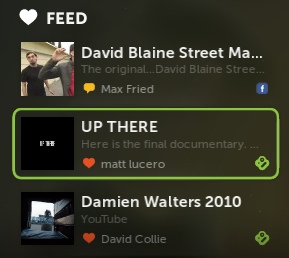I've long thought that the mobile devices we have in our home (tablets, iTouch, phones) would be our remotes. In fact, we use them everyday for that now. We use the Sonos app on the iPad to control the music in our house. We use the Boxee remote on the iTouch to control our TV. We all have apps on our androids and iPhones that control various devices in our home.
But as we were driving out to our beach house on friday afternoon, I realized that there is an alternative scenario. The mobile devices could be our primary content consumption devices and we will simply connect them to whatever device we want them to "play to."
That's how we and surely many others use the audio in our cars. We connect one of our many mobile devices to our auxiliary input in our car audio system and then play music. We play rdio, rhapsody, mog, fredwilson.fm, hypem, and sometimes local files on our mobile device and use the car audio system for the amplification and speakers throughout the car. We sometimes use the am/fm and siriusxm radio we have in the car. But the vast majority of listening happens on the mobile devices connected via the auxiliary input. We have the various subscription and free internet audio services on our mobile devices, not in our car dashboard.
That's how we use the telephone in our car too. Our mobile phones are connected via bluetooth to the car speakers and microphone. Our address books are on our mobile phones, not in the car dashboard. Our connections to the voice networks are on our mobile devices, not the car dashboard.
And we are quickly seeing video services show up on tablets. My friend Jimmy was at our beach house in long island on friday night. He showed me the Cablevision iPad app. If you can simply "play" the video on the iPad on the TV via a technology like Apple's Airplay, then the iPad becomes more than the remote. It becomes the set top box replacement.
The implications of this alternative scenario are profound. The subscription services might be on the mobile devices, not the displays. If your friend has an MLB.com subscription on his or her tablet and they come over to your house, you could watch the game on your TV via your friend's tablet.
That's how it works with audio today. My kids' friends come over and connect their phones and iTouch devices to our audio system and play their music on it. It seems highly possible that this model will continue to develop and include video as well. And if this becomes the dominant model then the video and audio systems will remain "dumb" and the smarts will be in the mobile devices.
I think its a bit too early to know which way the market will evolve. The auto industry and the consumer electronics industry have been pushing to get smart processers, operating systems, and internet connections into their products. There's a lot of energy going into that approach right now. But consumers are moving even faster than the manufacturers right now and the market may evolve in a different direction before the manufacturers can catch up. It will be interesting to watch how this plays out.




